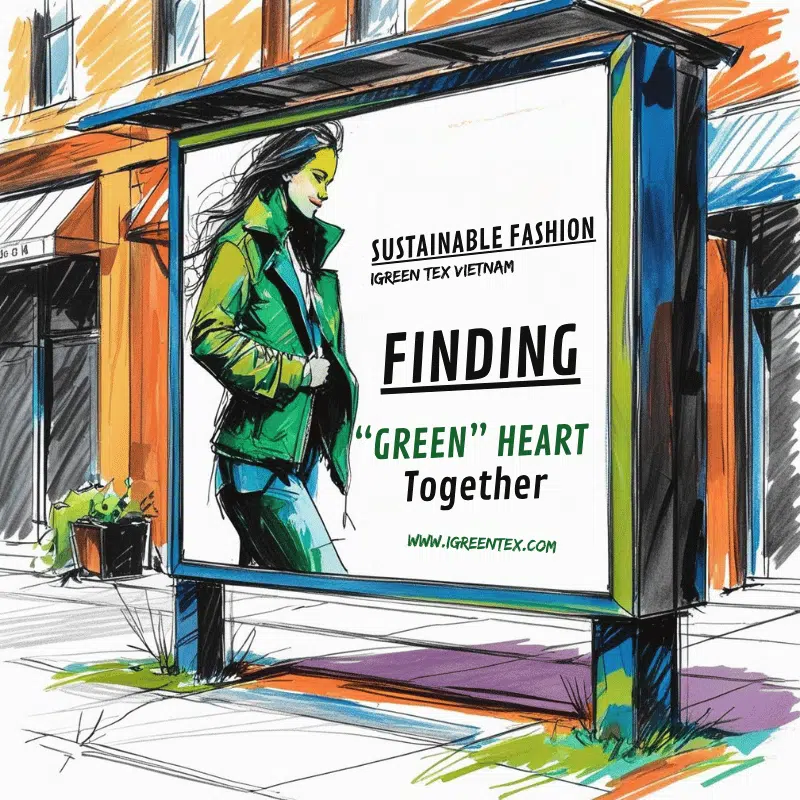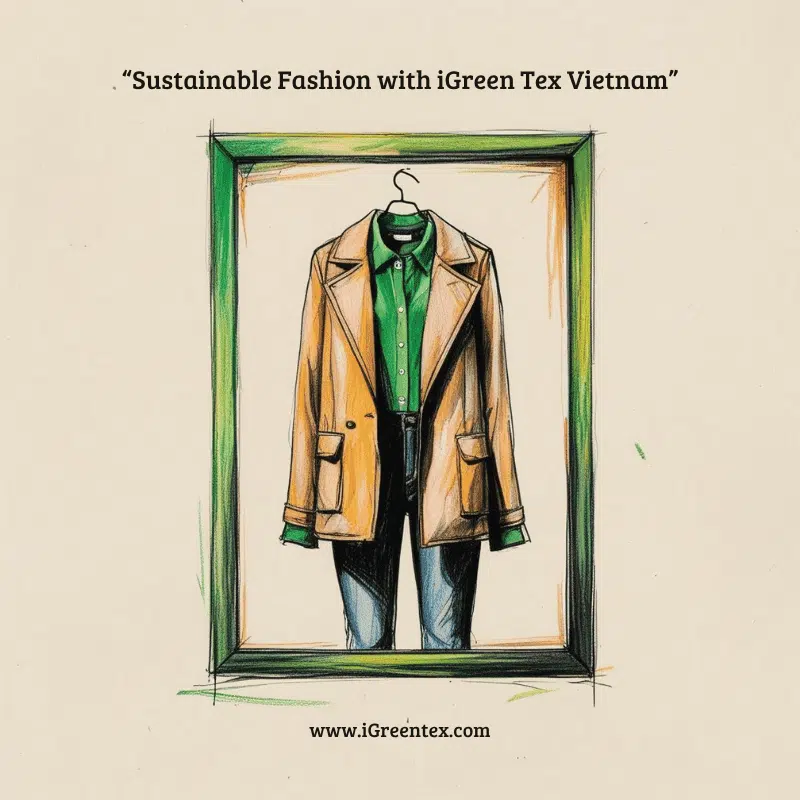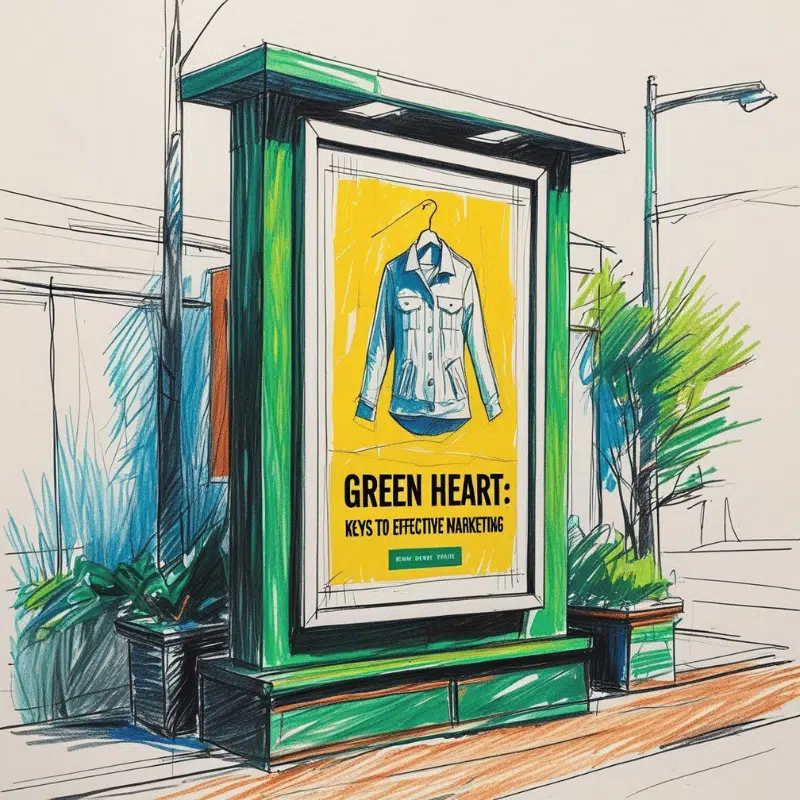- Reaching the “Green” Heart: Keys to Effective Marketing Sustainable Fashion to Conscious Consumers with iGreen Tex
- The Psychology Behind Conscious Shopping Decisions
- The Art of Sustainable Storytelling
- Channel Strategy for Maximum Impact
- Creating Compelling Content That Converts
- The Role of Supply Chain in Marketing
- Building Long-Term Relationships
- The Future of Sustainable Fashion Marketing
- Your Action Plan for Success
- Conclusion: Your Journey Toward Authentic Sustainable Fashion Marketing
- About IGREEN TEX
- IGREEN TEX VIETNAM CO LTD
Reaching the “Green” Heart: Keys to Effective Marketing Sustainable Fashion to Conscious Consumers with iGreen Tex
You spent months finding the perfect sustainable materials. You worked with ethical factories. You created beautiful, responsible clothes. But now comes the hardest part: getting customers to notice and trust your brand. This is where most sustainable fashion brands struggle. They make great products but fail at marketing sustainable fashion to conscious consumers.

The problem isn’t your products. The problem is communication. Today’s customers have heard too many empty promises about sustainability. They don’t trust green claims anymore. They need proof, stories, and real connections before they buy. Your challenge is to break through this skepticism and show them why your brand is different.
Marketing sustainable fashion to conscious consumers requires a completely different approach than regular fashion marketing. You can’t just talk about style and trends. You need to speak to values, impact, and authenticity. This guide will show you exactly how to do that, using proven strategies that work in today’s market.
See more: Vietnam Apparel Production Scalability for Streetwear Brand
See more: Ethical Streetwear Production Vietnam
See more: Vietnam’s Textile Innovation Hubs for Streetwear Development
See more: Risk Mitigation Strategies for Manufacturing Streetwear
See more: Quality Assurance Benchmarks for Vietnamese-Made Streetwear
See more: How to Build Partnerships Vietnamese Apparel Factories
The Psychology Behind Conscious Shopping Decisions
Before you write a single marketing message, you need to understand what drives conscious consumers. These customers make buying decisions differently than regular shoppers. They don’t just ask “Do I like this?” They ask “What does buying this say about who I am?”
Conscious consumers see shopping as a form of voting. Every purchase is a statement about their values. When they buy sustainable fashion, they’re supporting a vision of the future they want to see. This means marketing sustainable fashion to conscious consumers is really about connecting with their identity and aspirations.

These customers often feel frustrated with the fashion industry. They’ve seen fast fashion harm the environment and exploit workers. They want to buy better, but they don’t know which brands to trust. Your job is to prove you’re worthy of their trust. This requires showing, not just telling, your commitment to sustainability.
The emotional journey of conscious consumers is complex. They feel guilty about past purchases. They worry about making the wrong choice again. They want to feel good about their buying decisions. Successful marketing sustainable fashion to conscious consumers addresses these emotions directly. You need to reduce their anxiety while increasing their confidence in your brand.
Understanding this psychology changes everything about how you approach marketing sustainable fashion to conscious consumers. You’re not just selling clothes. You’re offering peace of mind, alignment with values, and participation in positive change. This deeper understanding forms the foundation of effective sustainable fashion marketing.
The Art of Sustainable Storytelling
Stories are the heart of effective marketing sustainable fashion to conscious consumers. While facts build credibility, stories create emotional connections. The key is weaving your sustainability efforts into narratives that resonate with your audience’s values and aspirations.
Material stories transform technical specifications into compelling narratives. Instead of simply stating that you use recycled fibers, tell the story of transformation. Explain how plastic bottles become soft, comfortable fabric. Describe the innovation required to make this possible. When you’re choosing sustainable fabrics for apparel brands, each material choice becomes a story element that connects with customers who care about waste reduction.

Process stories help customers understand the complexity and care involved in sustainable manufacturing. Explain how you implement water conservation techniques in textile industry vietnam without making it sound like a boring technical manual. Focus on the benefits and the care taken to protect natural resources. Show how these processes require more time and attention than conventional methods, justifying any premium pricing.
Channel Strategy for Maximum Impact
Different platforms serve different purposes in marketing sustainable fashion to conscious consumers. Your strategy should leverage the unique strengths of each channel while maintaining consistent messaging across all touchpoints.
Your website serves as the foundation for marketing sustainable fashion to conscious consumers. This is where you house detailed information about your sustainability practices, supply chain transparency, and brand story. Create comprehensive pages that answer common questions about your materials, processes, and impact. Include downloadable resources like sustainability reports or care guides. Your website should be the definitive source for anyone who wants to learn more about your brand’s sustainability efforts.
Social media platforms excel at storytelling and community building when marketing sustainable fashion to conscious consumers. Instagram works particularly well for visual storytelling about your materials and processes. Share behind-the-scenes content showing how your products are made. Post about the people in your supply chain. Use Instagram Stories to give followers a real-time look at your sustainability efforts. The visual nature of the platform makes it perfect for showing rather than just telling.

Email marketing creates the most direct connection with customers interested in your sustainability message. Develop a dedicated email series that educates subscribers about sustainable fashion. Share updates about your environmental initiatives. Offer exclusive content about your supply chain or manufacturing processes. Email allows for more detailed storytelling than social media posts, making it valuable for marketing sustainable fashion to conscious consumers who want deeper information.
Content marketing through blogs and articles establishes your expertise in sustainable fashion. Write about industry issues, sustainability challenges, and solutions. Share insights about overcoming challenges in implementing ethical apparel production. This content serves multiple purposes: it educates your audience, improves your search engine rankings, and positions your brand as a thought leader in sustainable fashion.
Influencer partnerships can amplify your marketing sustainable fashion to conscious consumers efforts when done authentically. Look for influencers who genuinely care about sustainability, not just those with large followings. Their audience trusts their recommendations because they’ve built credibility around conscious living. These partnerships work best when influencers can visit your facilities, meet your team, and tell authentic stories about your brand.
Creating Compelling Content That Converts
Content is the vehicle that carries your sustainability message to conscious consumers. The most effective content for marketing sustainable fashion to conscious consumers combines education, inspiration, and proof in formats that engage your audience.
Educational content addresses the knowledge gaps that prevent conscious consumers from making confident purchasing decisions. Many customers want to buy sustainable fashion but don’t understand the differences between various eco-friendly materials or certifications. Create content that explains these concepts in simple terms. Develop comparison guides that help customers understand why your choices are better for the environment and society.

Behind-the-scenes content builds trust by showing the reality of your operations. Share photos and videos of your manufacturing processes. Introduce the people who make your products. Show how you implement sustainability practices in daily operations. This transparency is crucial for marketing sustainable fashion to conscious consumers because it proves your claims with visual evidence.
Impact stories quantify the difference your brand makes in the world. Share specific metrics about water saved, waste reduced, or communities supported. Create infographics that make these numbers easy to understand and share. Update these stories regularly to show ongoing progress. Conscious consumers want to know that their purchases create measurable positive change.
Customer stories provide social proof that resonates with potential buyers. Share testimonials from customers who chose your brand for sustainability reasons. Feature user-generated content that shows your products in real life. These authentic stories from real customers are more convincing than any marketing message you could create.
Problem-solution content addresses the frustrations that drive conscious consumers to seek alternatives. Write about the problems with fast fashion and how your brand provides solutions. Discuss the challenges of finding truly sustainable clothing and how you make it easier. This content helps customers understand why your brand exists and why they should choose you.
The Role of Supply Chain in Marketing
Your supply chain is not just about manufacturing; it’s a crucial part of your marketing sustainable fashion to conscious consumers strategy. Today’s conscious consumers want to know where their clothes come from, who makes them, and how they’re made. This demand for transparency turns your supply chain into a marketing asset.
Supply chain transparency builds trust by showing customers exactly how their products are made. Map your entire supply chain from raw materials to finished products. Share information about each step in the process. Introduce the farms where your cotton is grown, the mills where your fabric is woven, and the factories where your garments are assembled. This level of detail differentiates you from brands that hide their supply chain.
The business case for sustainable fashion manufacturing extends beyond environmental benefits to include marketing advantages. Sustainable practices create stories that resonate with conscious consumers. Fair labor practices provide human interest stories. Environmental initiatives demonstrate care for the planet. These practices become content for your marketing sustainable fashion to conscious consumers campaigns.
Challenges in sustainable manufacturing can actually strengthen your marketing message when handled transparently. Share how you’re overcoming challenges in implementing ethical apparel production. Discuss the extra time, effort, and cost required to do things right. This honesty builds trust and justifies premium pricing. It shows that you’re committed to your values even when it’s difficult.
Continuous improvement in your supply chain provides ongoing content for marketing sustainable fashion to conscious consumers. Share updates about new sustainability initiatives, improved processes, or expanded certifications. These updates show that you’re not resting on past achievements but continuously working to do better. This dynamic approach keeps your sustainability story fresh and engaging.
Building Long-Term Relationships
Marketing sustainable fashion to conscious consumers is not about one-time transactions. It’s about building long-term relationships with customers who share your values. These relationships require ongoing nurturing and authentic engagement.
Customer education is an ongoing process that strengthens relationships over time. Don’t just educate customers before they buy; continue teaching them after purchase. Share care instructions that help products last longer. Provide updates about your sustainability initiatives. Offer insights about conscious living. This continued education builds loyalty and positions your brand as a trusted resource.
Community building creates connections between your brand and customers while also connecting customers with each other. Create online spaces where customers can share their sustainability journeys. Organize events that bring conscious consumers together. Support causes that align with your values. These activities build a community around your brand that extends beyond individual products.
Feedback loops allow you to improve your marketing sustainable fashion to conscious consumers approach based on customer input. Regularly survey customers about their sustainability priorities. Ask for feedback on your environmental initiatives. Listen to suggestions for improvement. This feedback helps you stay relevant and responsive to changing customer needs.
Value-added services extend the relationship beyond the initial purchase. Offer repair services to extend product life. Provide take-back programs for end-of-life products. Create styling guides that help customers get more use from their purchases. These services demonstrate your commitment to sustainability while providing additional value to customers.
The Future of Sustainable Fashion Marketing
The landscape for marketing sustainable fashion to conscious consumers continues to evolve rapidly. Understanding emerging trends helps you prepare for future opportunities and challenges.
Technology is creating new possibilities for transparency and engagement. Blockchain technology can provide immutable records of supply chain practices. QR codes on garments can link to detailed information about materials and manufacturing. Virtual reality can give customers virtual tours of your facilities. These technologies enhance your ability to prove your sustainability claims and engage customers in new ways.
Regulation is increasing pressure on fashion brands to substantiate their sustainability claims. New laws in Europe and other markets require proof of environmental and social claims. This regulatory environment makes authentic sustainability practices more important than ever. Brands that have built genuine sustainability programs will have advantages over those that have relied on marketing messages alone.
Consumer expectations continue to rise as awareness of fashion’s environmental impact grows. Customers are becoming more sophisticated in their understanding of sustainability issues. They’re asking more detailed questions and expecting more comprehensive solutions. This trend favors brands that have invested in real sustainability improvements over those that have focused only on marketing.
Collaboration is becoming more important as the industry recognizes that individual brands cannot solve sustainability challenges alone. Industry-wide initiatives, shared standards, and collective action are growing. Brands that participate in these collaborative efforts can leverage shared credibility and resources. This cooperation enhances individual marketing sustainable fashion to conscious consumers efforts.
Circular economy principles are reshaping how brands think about products and marketing. Design for durability, repairability, and recyclability becomes part of the marketing message. Take-back programs and resale platforms extend the brand relationship. These circular approaches create new opportunities for marketing sustainable fashion to conscious consumers while reducing environmental impact.
Your Action Plan for Success
Implementing an effective marketing sustainable fashion to conscious consumers strategy requires systematic planning and execution. This action plan provides a roadmap for getting started and building momentum.
Start by conducting a comprehensive audit of your current sustainability practices and marketing messages. Document what you’re already doing well and identify areas for improvement. Gather evidence for your current claims and identify gaps where you need more proof. This audit provides the foundation for your marketing sustainable fashion to conscious consumers strategy.
Develop clear, specific sustainability goals that guide both your operations and marketing efforts. These goals should be measurable, time-bound, and aligned with customer expectations. Share these goals publicly to create accountability and show your commitment to continuous improvement. Goals provide structure for your marketing sustainable fashion to conscious consumers narrative.
Create a content calendar that tells your sustainability story systematically over time. Plan content that educates customers, shares behind-the-scenes information, and demonstrates impact. Include seasonal elements like Earth Day or Fashion Revolution Week. This planned approach ensures consistent messaging and maximizes the impact of your marketing sustainable fashion to conscious consumers efforts.
Build partnerships with suppliers, organizations, and influencers who share your values. These partnerships extend your reach and add credibility to your message. Look for opportunities to collaborate on content, events, or initiatives. Strong partnerships amplify your marketing sustainable fashion to conscious consumers efforts.
Invest in measurement and optimization systems that track both marketing performance and sustainability impact. Set up regular reviews of your metrics and adjust your strategy based on results. This data-driven approach ensures your marketing sustainable fashion to conscious consumers efforts continue to improve over time.
Conclusion: Your Journey Toward Authentic Sustainable Fashion Marketing
Marketing sustainable fashion to conscious consumers is both a challenge and an opportunity. The challenge lies in building trust with skeptical customers who have been disappointed by empty promises. The opportunity lies in connecting with customers who desperately want to support brands that share their values.
Success requires authenticity, transparency, and genuine commitment to sustainability. You cannot fake your way to success in this market. Conscious consumers are too smart and too passionate to be fooled by superficial claims. However, brands that invest in real sustainability improvements and communicate them effectively will find a loyal, engaged audience.
At iGreen Tex Vietnam, we understand the importance of marketing sustainable fashion to conscious consumers because we see how our manufacturing practices impact our partners’ ability to tell authentic stories. We provide the transparency, documentation, and genuine sustainability practices that make credible marketing possible.
Our facilities implement advanced water conservation techniques in textile industry vietnam that reduce environmental impact while maintaining quality. We support brands in choosing sustainable fabrics for apparel brandsby providing detailed information about material properties and environmental benefits. We work continuously on overcoming challenges in implementing ethical apparel production while maintaining the transparency that conscious consumers demand.
We invite you to visit www.igreentex.com to learn more about how we can support your marketing sustainable fashion to conscious consumers efforts. Together, we can build a fashion industry that serves both style and sustainability, creating value for businesses, customers, and the planet.
The future of fashion is sustainable, and the brands that master marketing sustainable fashion to conscious consumers will lead that future. Your journey starts with the commitment to do better and the courage to tell your story authentically. Your customers are waiting to hear from you.
About IGREEN TEX
IGREEN TEX is a provider of fashion and textile products, offering a wide range of both domestically and internationally. Our commitment to quality ensures that our products not only meet the highest standards but also promote eco-friendly practices, in Vietnam sportswear manufacturing.
If you want to read more information about canvas bags, and if you want to tote bags at Tphcm, you can see it here!!!
To view product information click here
Visit our website to learn more about our products and services: IGREEN TEX
IGREEN TEX VIETNAM CO LTD
Address: No. 6 – 6A, D52 Street, Ward Bay Hien, HCMC
E-mail: info@igreentex.com
WhatsApp/Viber/Zalo: +84 938.045.900